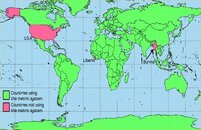Scuba seems to be rather unique using bar. Pascals (kPa) seems to relate closer to PSI than bar, at least for me.
1 pascal =
0.000145037738 pounds per square inch
What?! How does it relate closer to PSI? 1 bar = 10^5 Pa.
Welcome to ScubaBoard, the world's largest scuba diving community. Registration is not required to read the forums, but we encourage you to join. Joining has its benefits and enables you to participate in the discussions.
Benefits of registering include
Scuba seems to be rather unique using bar. Pascals (kPa) seems to relate closer to PSI than bar, at least for me.
1 pascal =
0.000145037738 pounds per square inch
Huh? You DO know that 1 bar = 100 kPa, don't you?Pascals (kPa) seems to relate closer to PSI than bar, at least for me.
Yes, which is why it would be much easier to convert "every day life" to metric. You'd save a lot of time in school learning stuff that are completely pointless and unnecessary exercises in a metric world.
Huh? You DO know that 1 bar = 100 kPa, don't you?
BTW, bar isn't an SI unit, but it's very useful because it's so close to one standard atmosphere. The difference is just 1.3%
--
Sent from my Android phone
Typos are a feature, not a bug
I'm not arguing that and it certainly isn't a straw man. I'm well aware that for the simplest things in daily life, it doesn't matter either way. There's no advantage in using metric and there's no advantage in using imperial. The difference arises when you look at the not-as-simple cases and look outside of daily life. Then there's a clear advantage in using metric over imperial, which is why all the scientific circles use metric only. So now there's the question of whether using metric everywhere has an advantage over using metric only in some cases and using an obsolete and cumbersome system in other cases. Yes, of course there is.You know, you're really just concocting a straw man argument. All we really need to know for daily life is how many quarts or pints to a gallon and how many inches per foot. The rest don't come into play much, and for the rare cases they do, we've got these new-fangled handheld computers.

I don't get it, how does it relate to PSI better? They're all measures of pressure.You do know that bar is related to atmospheric pressure, I am glad. Other than units for Scuba, what value is in a real world application? kPa is far more useful and relates to PSI better. IMO
I don't get it, how does it relate to PSI better? They're all measures of pressure.
And which real life purposes would that be? Like pressure in bicycle or car tires, which often is given in bar? Or you mean things like atmospheric pressure, which is usually given in hPa (1000 hPa = 1 bar), but where you guys don't use PSI but rather inches of mercury (which equals a convenient 0.491098 PSI for conversion purposes)?It may well relate perfectly to Scuba. I think it does. but for real life purposes Bar is pretty useless.

